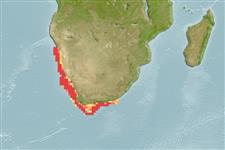Actinopterygii (ray-finned fishes) >
Ophidiiformes (Cusk eels) >
Ophidiidae (Cusk-eels) > Ophidiinae
Etymology: Genypterus: Greek, geny, -yos = face, jaw + Greek, pteron, = wing, fin (Ref. 45335).
Environment / Climate / Range
Ecology
Marine; bathydemersal; depth range 50 - 500 m (Ref. 4103), usually 250 - 350 m (Ref. 27121). Deep-water, preferred 21°C (Ref. 107945); 21°S - 37°S, 12°E - 28°E (Ref. 34024)
Eastern Atlantic: Walvis Bay, Namibia to Algoa Bay, South Africa. Distinctiveness of this species and Genypterus blacodes is unclear (Ref. 34024).
Length at first maturity / Size / Weight / Age
Maturity: Lm ?, range 60 - 75 cm
Max length : 180 cm TL male/unsexed; (Ref. 3686); max. published weight: 15.0 kg (Ref. 9988)
Short description
Morphology | Morphometrics
Occur in rocky areas of the shelf and upper continental slope. Juveniles found in shallow waters than adults (Ref. 36731). Benthic and common species (Ref. 34024). Feed on dragonets, mantis shrimps, hake, squid, and various fishes (Ref. 27121). Spawning occurs from August to October. Oviparous, with oval pelagic eggs floating in a gelatinous mass (Ref. 205). Utilized fresh and frozen; can be fried and baked (Ref. 9988).
Nielsen, J.G., D.M. Cohen, D.F. Markle and C.R. Robins, 1999. Ophidiiform fishes of the world (Order Ophidiiformes). An annotated and illustrated catalogue of pearlfishes, cusk-eels, brotulas and other ophidiiform fishes known to date. FAO Fish. Synop. 125(18):178p. Rome: FAO. (Ref. 34024)
IUCN Red List Status (Ref. 115185)
CITES (Ref. 94142)
Not Evaluated
Threat to humans
Harmless
Human uses
Fisheries: commercial
More information
ReferencesAquacultureAquaculture profileStrainsGeneticsAllele frequenciesHeritabilityDiseasesProcessingMass conversion
Tools
Special reports
Download XML
Internet sources
